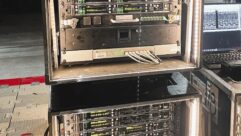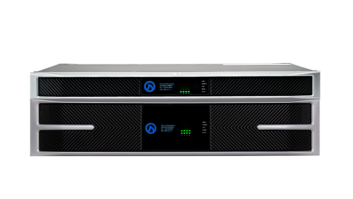

COPENHAGEN, DENMARK – AUGUST 2014:
Sune Snellman Jakobsen is a live mix engineer stationed in Copenhagen, Denmark whose credits include world tours with The Raveonettes, Mew, Mercury Rev from NY, Kashmir from Denmark, and, most recently, TrentemA¸ller. An avid Metric Halo user, Jakobsen owns a ULN-8 interface and a LIO-8 interface and regularly uses their SpectraFoo sound analysis software to set up shows and to help identify and solve problems while mixing. His interfaces carry Metric Halo’s optional +DSP, which allows him to run their powerful plug-ins on critical live channels (including the whole mix!).
Jakobsen’s entry into the industry was not so worldly, nor so high-tech, but it set him on the right path. “I became interested in audio as a member of the underground punk scene in Copenhagen during my teenage years,” he said. “I played guitar in punk bands and hung out in a punk club where some older guys taught me the basics of mixing consoles, multi-way speaker systems, stage monitors, and all that. Neither the bands nor the audience cared too much about fidelity or clarity, so I could mix shows night-after-night and no one complained about my dreadful mixes. It was hard on the ears but good practice for a novice.”
One of Jakobsen’s punk rock mentors recommended him for a job with one of Denmark’s leading PA companies, and he spent the next several years prepping outboard racks, packing house-boxes for rentals, driving trucks, rigging PAs, and patching microphones on tours and festival stages. “The whole timeA I was looking over the shoulders of all the experienced and skilled monitor and FOH engineers,” he said. “I soon moved from rigging and miking to actually operating the boards, which was exciting. I got pretty good at mixing monitors, and I was able to mix FOH for a few up-and-coming acts.”
As his skills and industry contacts grew, more bands hired Jakobsen to engineer their shows, prompting him to make the move to full-time freelance. After some years of regional touring with local bands, he signed on to a worldwide tour with The Raveonettes. “The band had just landed a major label deal and had a lot of hype going so we went back and forth from European to U.S. club tours and festivals,” he said. “We performed on the Late Show with David Letterman a few times, Conan, Jimmy Kimmel Live!, numerous radio sessions, and support-tours with Depeche Mode, Interpol, The Strokes, Supergrass and many others. Those support tours were great because they gave me new opportunities to learn from great live engineers.” When The Raveonettes finally took a break after six years of constant touring, Jakobsen signed on with Mew and, later, TrentemA¸ller.
“As a FOH engineer, I think it’s important to embrace the sonic ideals of the artist,” Jakobsen said. “I don’t see any point in applying my own favorite flavor if it doesn’t appeal to the artist. Along those lines, it’s critical to build a relationship of trust so the artist feels I have an understanding and appreciation of what their music should sound like. It was an interesting transition to go from The Raveonettes’ minimal, noisy, and reverb-y soundscape to Mew’s big sonic universe, with big pounding drums and layers of pads, guitars, and backing vocals.” Although still working with Mew, Jakobsen began touring with TrentemA¸ller in 2010, which took him to European arenas in support of Depeche Mode, 3,000-seat headlining gigs, and plenty of European festivals. “I’m still fascinated by the way a good mix can lift a music experience (and how a bad mix can ruin a show), and I’m still intrigued by how difficult it is to reinforce audio and to mix,” he said. “I like the combination of creativity, technical skills, and science. It’s an ongoing learning experience, and that’s cool.”
SETTING UP THE SHOW
Jakobsen seldom has more than a short window to load in, set up, check the PA, and sound check before doors open. One of the first things he addresses is the PA system performance: “The frequency response should be full range and both level and response should be as uniform as possible throughout the audience area. I use Metric Halo SpectraFoo sound analysis software on most every gig to analyze and help tune the PA system.” He typically sends pink noise to one side of the PA, feeds the same signal to SpectraFoo’s Transfer Function source channel, places his Earthworks M30 measuring mic somewhere on-axis, and feeds its output to the Transfer Function response channel. He then time aligns the two signals with SpectraFoo’s Delay Finder and takes a snapshot of the response. He repeats this process with the mic at several other locations – a little farther or closer, and on or off axis. He marks the snapshots in SpectraFoo’s overlay list and asks it to calculate an average.
“That,” he said, “is then my visual reading of the system. I immediately get an idea of the PA at hand and whether it’s reasonably linear or not. Sometimes I’ll spot an issue even before I listen to music. For example if there’s a broad dip in the 1k-6k range it could indicate the gain settings in the system crossover aren’t right and the hi-mid drivers are gained too low. Or a dip at the crossover frequency of the sub and the low-mid could indicate phase or timing issues with the subs. It’s of course important to listen to reference music and tune with the ears in addition to the SpectraFoo output, but the visual plot is a great help in locating problem frequencies.” He uses SpectraFoo’s Delay Finder along with the phase response of the Transfer Function to time-align subwoofers, fills, and delay speakers if necessary. During sound check, he uses its Correlation Meter and Phase Torch to verify phasing between sources (e.g. bass DI and bass mic). Ringing the system with Spectragraph allows him to quickly identify and notch out problem frequencies with the Metric Halo EQ plug-in.
MIXING THE SHOW
Jakobsen described his mix philosophy: “The mix itself must complement the music and should hopefully impress and overwhelm the audience. All of the instruments should be well-defined within the mix. Vocals should almost always be on top of the mix, and lyrics should beA audible. I tend to favor ‘wall of sound’ mixes, with gaps in the soundscape filled by anything available from stage, perhaps by mixing guitar parts up very close to the vocal or adding lush reverb to drums or percussion. I like to be overwhelmed by sound when I’m in the audience, so I aim to do the same when I’m mixing. I think one key to an interesting mix is to feature supporting roles as much as lead roles, be it a rhythm guitar or a tambourine or whatever; I think it helps keep people’s attention when all the different roles are well defined.”
Jakobsen uses his Metric Halo ULN-8 and LIO-8 along with the free Metric Halo MIO Console control software as an audio “multi-tool.” MIO Console allows him to route signals and to operate the DSP resources he has installed on the interfaces. With TrentemA¸ller, he reserves the Metric Halo gear for the tracks that need the most processing: vocals, kick drum and snare drum. “I’m not aware of any other interface that has the combination of such great-sounding preamps, transparent converters, sublime mix bus processing, and all of the DSP tools necessary: unlimited bands of precise EQs, compression, limiting, delay, and ‘character’ modeling. At the same time, it gives me a straightforward interface for recording and playback.”
For vocals, Jakobsen uses Metric Halo’s “Classic British Mic Pre” character, followed by a “MIOstrip” loaded with a six-band EQ for sweetening, two compressors with complementary fast and slow settings, a second six-band EQ for notching out problem frequencies, and a very fast compressor with a side chain high-passed at 5kHz to serve as a de-esser. “In addition, I use the ‘California Vocal Box’ character on the vocal’s master strip, which I find adds a nice grainy texture,” he said. “For the current tour, TrentemA¸ller asked for a vocal distortion for a few songs. I made a virtual MIO channel and tried different combinations of the Pedal and Amp macros. I ended up with a combination of the ‘Screamer’ into the ‘MHClean’ with some delay and a lot of compression and EQ. It sounds great!”
Jakobsen uses similar processing for the kick and snare drum. ” I almost always mix drums into a group and insert a stereo ULN-8 or LIO-8 input, split that into two stereo channel strips in MIO Console – one with no processing (or perhaps just Metric Halo’s Transient Designer) and one with a hard squashing compressor, Transient Designer, and often a bit of soft clip to give the drums an edgy character,” he said. “Those channels sum to a stereo output that’s a killer parallel compression drum group insert. I even have the option to add different characters to the drum group, for example the ‘Soft-Saturation’ character for a fatter and more punchy sound, and I have an EQ on the output bus that allows me to cut boomy frequencies in the low end or add high-end brilliance on the fly.”
Finally, Jakobsen sends the entire mix into a stereo MIO Console channel that gets routed to two auxiliary groups, one with “SoftSat” Character applied and one without. “I can then mix between these two depending on the PA system of the day,” he said. “It’s like having a wet/dry control on the SoftSat Character, which can really make the PA system sound like it’s ‘in your face.’ Then I route that mix to multiple master busses with different EQs and delays for the main PA, the subs, fills, and delays.” During the performance, Jakobsen keeps SpectraFoo open with a Level Meter on the house sound, a Spectragram and a Spectragraph on the mix bus, and a Spectragraph on the solo bus for quickly diagnosing problems with individual channels. “It’s especially helpful for getting the low-end even. If I hear a boomy note in the bass, it’s easy to identify with SpectraFoo,” he concluded.
ABOUT METRIC HALO
Now based in the sunny city of Safety Harbor, Florida, Metric Halo provides the world with high-resolution metering, analysis, recording and processing solutions with award-winning software and future-proof hardware.










